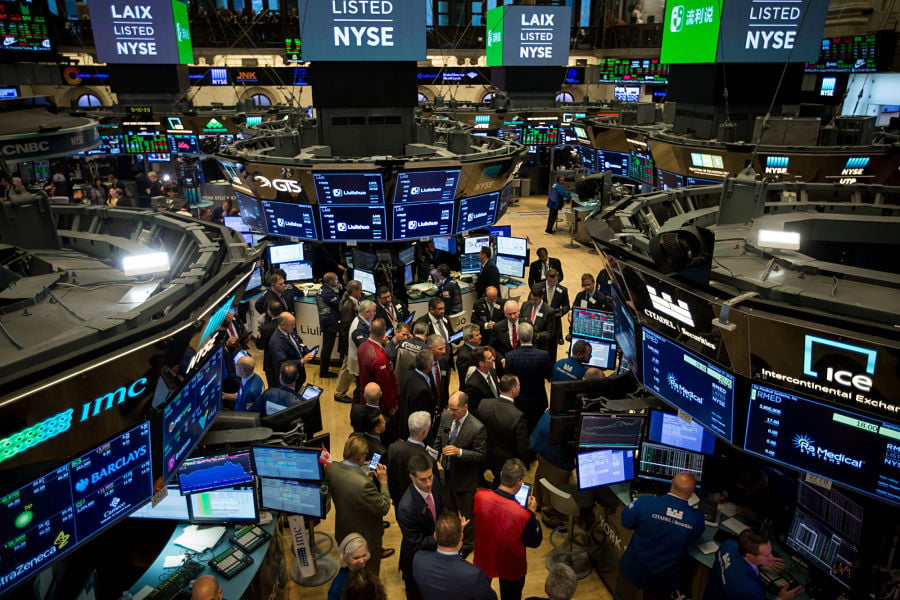Valuations aren't stopping it. Jerome Powell's softer tone failed to soothe anyone. The moratorium on tariffs is a fading memory and now the sturdiest chart level of the year is in danger of giving way.
A stock rout that bulls thought was finished three different times since October is in a new and ominous phase, with the Dow Jones Industrial Average losing 1,004 points in two days. No Santa Claus rally. Instead, the S&P 500 index is hurtling toward the second-worst December on record.
"The stock market doesn't care what looks good now. It's wondering if fundamentals will deteriorate in the future," said Peter Mallouk, co-chief investment officer of Creative Planning, which has around $36 billion under management. "You have a lot of people that are scared, and they're sitting on the sidelines to wait it out."
Waiting it out is starting to look like the only viable strategy. On Monday, the S&P 500 briefly pierced a level that had been a psychological foundation for 10 months, its intraday low from Feb. 9. Valuations shrink and shrink — computer and software stocks trade at 15 times next year's earnings estimates, cheaper than utilities and soapmakers — and the selling just gets worse.
With Monday's 54-point loss, the S&P has now fallen 2% or more six times this quarter. The Nasdaq Composite has done it 10 times. Both are the most since the third quarter of 2011.
Pinning a single cause on the carnage has become an exercise in absurdity, with analysts cycling through a rotating list of reasons that include trade, President Donald J. Trump's legal travails, China data, sinking oil and cooling home prices. Anyone daring to suggest economic growth may slow in 2019 is pointed to charts showing factories, employment and profits are booming — but those assurances are starting to fall on deaf ears.
Despite indicating a potential respite in early Asian trading Tuesday, S&P 500 Index futures reversed gains to trade little changed as of 1:35 p.m. Hong Kong time.
Investors "are too worried, but that's the big driver behind the declines we've seen recently, overall worries about U.S. growth and worries about global growth," said Kate Warne, investment strategist at Edward Jones. "Investors have gotten very nervous about the changes they're seeing ahead and they're uncertain about what they mean."
A troubling sign for Americans: Equity pain, which all year has been worse overseas, is landing with more force in the U.S. The Russell 2000 Index of small caps, a proxy for domestically oriented companies, slid into a bear market Monday, falling 21% since Aug. 31.
On the other hand, since hitting a 19-month low in late October, the MSCI Emerging Markets Index has trended higher, even as the S&P 500 Index keeps making new lows. Stocks in the EM gauge have outperformed the S&P 500 for three consecutive weeks, the most since late January, data compiled by Bloomberg show.
To comfort themselves in the face of such depressing facts, beaten-up investors have looked at past corrections and noticed that this one is still playing out according a relatively benign plan. Under the pattern, major swoons that have interrupted the bull market that began in 2009 have taken around 100 days to tire out before dip-buyers swooped in to put things right.
At the same time, anyone betting the New Year will bring an end to the volatility should be aware that bull markets can die slow deaths. The 88-day sell-off has been going on roughly one-third as long as it has taken for the S&P 500 to fall into the 11 bear markets it's suffered going back to World War II.
How many more sellers than buyers were there on Monday? The volume of stocks trading lower on the New York Stock Exchange reached 1 billion shares, compared with 158 million that were bought. The difference in trading volume, at 883 million shares, is on track to become the biggest weekly gap since 2016, data compiled by Bloomberg show.
That the worst two-day sell-off since October landed on the same week Mr. Powell's Federal Reserve is expected to announce its ninth interest rate hike was grist for those who see central bank policy behind everything. As willingly as the Fed chairman has
walked back his most hawkish pronouncements, nobody thinks monetary policy is likely to loosen even as growth in the economy and earnings slows from this year's pace.
(More: Fed hikes are rare when stocks are this battered)
"That's what the market is struggling with right now — do they believe in a growth slowdown to trend or something more sinister than that?" said Phil Camporeale, managing director of multi-asset solutions for JPMorgan Asset Management. "I don't think people really want to take risk, but especially trying to catch a falling knife on equity prices."
(More: With stock market in a correction, is a recession just ahead?)







